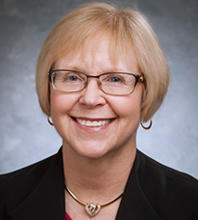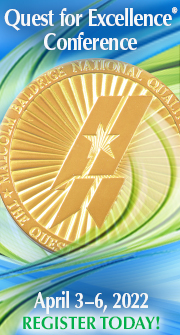Blogrige
The Official Baldrige Blog


The Baldrige Program’s 33rd Quest for Excellence® Conference brings together the leaders of U.S. organizations to celebrate and learn role-model best practices from current and former Baldrige Award recipients.
Attendees take home practical lessons in critical areas such as leadership, strategy, customer and employee engagement, and operations. The speakers also provide attendees with proven solutions to help their organization achieve breakthrough performance and results.
At the upcoming 33rd Quest for Excellence Conference, where award recipients from the past three years will be honored, Patricia Skriba—retired vice president of business excellence at Advocate Good Samaritan Hospital (GSAM) and former chair of the Baldrige Judges Panel—will present the preconference workshop “Getting Acquainted with Baldrige.”
Following is my recent interview with Skriba. As GSAM is a 2010 Baldrige Award recipient, Skriba reflected on how the Baldrige Excellence Framework inspired its journey to excellence, how other organizations might also leverage the framework to improve their organization’s performance, and how the framework has continued to inspire her both personally and professionally.
What are your key objectives for your workshop, “Getting Acquainted with Baldrige,” at the 33rd Quest for Excellence Conference?
For many, the Baldrige framework is daunting and complex. So, my three objectives are simple, but not easy!
1. Demystify Baldrige.
First, I seek to “demystify” Baldrige—to help participants understand that the framework is practical, is intended to help organizations get better, and is about formalizing what they are probably already doing. Part of this demystifying involves translating and communicating Baldrige-ese into language that resonates with leaders and practitioners.
2. Get Started.
My second objective is to give participants a few bite-size ways to begin:
- We will explore the decisions that senior leaders need to make in order to write an Organizational Profile.
- We will experience the Are We Making Progress? survey that can be used with the workforce and leaders to identify gaps in fundamental approaches.
- Lastly (and my favorite), we will talk about how organizations are made up of processes.
A fundamental principle is that “an organization is perfectly designed to get the results they are getting.” Having key processes or approaches defined, deployed/used, measured, and improved for what is important to the organization will yield better results—Baldrige calls this “ADLI” (Approach, Deployment, Learning, and Integration).
During the workshop we will select a few approaches in the framework itself and practice how to begin ADLI. This discussion often is an “ah ha” moment for participants as they begin to shift from writing an application to embracing a practical way to use the framework to improve.
3. Energize Your "Why."
My third objective is to energize a bigger "why" for Baldrige. A why that is less about the award and more about embracing a journey of performance excellence—pursuing a place where our students, our customers, our patients, and our employees can count on us for excellence.
Would you share an example from your work in regard to using the Baldrige framework?
Baldrige is a blueprint of key approaches that individually and collectively work together to yield exceptional, sustainable results. For example, one approach in the framework is the Performance Improvement System. At GSAM, we determined that the main approach to performance improvement was the Plan-Do-Study-Act (PDSA) method. We then asked ourselves three questions:
- How many people are trained in PDSA?
- How many truly use it?
- How many real improvements do we experience?
These questions highlighted our opportunities! Though we had “trained leaders,” they did not really understand how to use PDSA, and the number of improvements were underwhelming. This led us to make cycles of improvement to our approach.
We eventually adopted A3-PDSA and engaged in a rigorous deployment of that approach. We began to create a community of problem solvers and began to experience hundreds of improvements from all levels of the organization.
The performance improvement approach was one of many Baldrige-based approaches that went through similar maturing at GSAM. Seeing the Baldrige framework as a blueprint of key processes or approaches was helpful. When we experienced challenges or underperforming results, looking at our key approaches guided us to process-based improvements.
What are your top tips for an organization’s first self-assessment using the Organizational Profile?
Tip #1
The Organizational Profile defines what is key and important for your organization and sets the stage for the writing of an application or to inform your improvement work. The processes in categories 1-6 should be applied to what you said was important in the Organizational Profile and category 7 should have evidence that what you said was important is measured.
For example, if you are in secondary education and in the Organizational Profile you said that one of your challenges is students dropping out before graduation, then the processes outlined in category 3 (customer) should be used to address that challenge; in category 7.2, results related to student retention should be present.
Don’t consider the Organizational Profile as a separate document. Take time to make sure that what is in the Organizational Profile is what’s truly important to your organization; then ensure your improvement work and your application integrates what you said was important.
Tip #2
Many organizations see the Organizational Profile as a writing assignment that gets delegated to someone in quality or performance improvement. If this is the case, you may not experience a self-assessment.
There are about 65 “what” questions that need to be answered in the Organizational Profile; many of these questions can be answered (with some investigative work) by a nonsenior leader. However, there are some questions that are really key decisions that are best made through the consensus of the senior leader team. If these are not viewed as leadership decisions, then your Organizational Profile may be good guesses.
Below are some key decisions in the Organizational Profile that usually require senior-leader consensus:
- What are your main product/service offerings?
- What are the key groups/segments of your workforce and customers?
- What are your key drivers of workforce engagement?
- What are the requirements of your customers/patients?
- What are your key strategic challenges and advantages?
- What is your performance improvement approach?
As senior leaders discuss these key decisions, a self-assessment occurs because often they have not been previously determined or differences in opinion may emerge. Through the use of data, consensus can occur; and this results in an Organizational Profile that reflects a solid understanding of your organization.
What do you view as primary ways that organizations today can benefit from using the Baldrige framework?
I’ve asked myself multiple times, “What does Baldrige have to do with COVID?” My observation is that resilience is enabled through mature processes. If we took seriously the work of Baldrige—defining/documenting processes, deploying them well, measuring, and improving them—organizations would have a “process-advantage” in a crisis.
Imagine having these approaches mature and then using them (maybe modifying them) versus starting from scratch. In COVID, for example, if these Baldrige-based approaches were present in an organization when COVID began, they may have given organizations a better starting place and an ability to be more agile and resilient.
- Senior Leader Communication: Which existing approaches will we capitalize on during this pandemic/crisis? Do we need additional ways to communicate? What content will be shared when/where?
- Enterprise Risk System: What could go wrong? What risks do we have (e.g., employees, customers, community, society, financially, ethically, operationally)?
- Voice of the Customer: Do we have mechanisms to listen to customers and stakeholders during these changed circumstances?
- Customer Relationship: How will we continue building relationships with our customers during this crisis?
- Performance Measurement: What measures do we need to keep our eyes on? When/who will we review? How will we launch performance improvement?
- Knowledge Management: What specific knowledge do we need transferred? What mechanisms will we use to ensure transfer of knowledge to/from employees/customers? Do we need additional?
- IT and Data/Information Management: What IT implications are there? How will data/information be available?
- Supply Chain: What will we need? Will our process give us what we need when we need it? What needs to change?
- Workforce Planning: What staffing and skills will we need? Does our process allow us to be agile? How will we communicate changes? Do we need new roles?
- Workforce Engagement: How do we engage our workforce during this crisis?
- Health/Safety/Security: How do we keep our employees safe/secure/healthy?
- Business Continuity: What if the worst happens? Do we have a plan?
Elevator Pitch about the Baldrige Framework: If given just 1 to 2 minutes to describe the Baldrige framework to a group of senior leaders in my sector, I would describe it as a blueprint of key organizational approaches or processes that when defined, used, measured, and improved create an “operating system” that improves an organization’s performance over time and promotes sustainability.
Given what you’ve learned from applying the Baldrige framework in your work, are there ways you’ve also applied it in your personal life?
Postretirement I was asked to do some consulting. My first step was to create an email address; I chose one that began with pursuing.excellence2. It didn’t take me long to realize that my approach to life is about pursuing excellence, both professionally and personally.
There have been times in my personal life when I realized that I was not getting the “results” that I had hoped for (e.g., in my relationships, finances, health). I then think of the four dimensions of the Baldrige process item scoring guidelines: ADLI.
Sometimes my approach is a little too ad hoc and needs more formalizing, or I am not consistent with using my approach (it’s not well deployed in me!); or I need to improve my approach and learn how through feedback, benchmarking, and so on; and then I must ensure that what I commit to is integrated into my thinking and my actions. ADLI is a valuable tool for life improvement!
Has your perception of the Baldrige community (e.g., award recipients, examiners, judges and overseers board members and alumni, other framework users) changed since your organization became a Baldrige Award recipient?
I am an advocate for and an “evangelist” of the Baldrige framework. I have played many supporting roles—applicant, recipient, state program examiner/judge, national program judge/chair; and speaker/presenter.
The Baldrige community is a very warm, helpful, generous group of professionals who have a common passion and a drive to
- seek excellence,
- serve patients/customers/communities in the best possible way,
- share generously so others can improve, and
- continually learn.
Baldrige Community: There is no other professional group, in my opinion, that surpasses the Baldrige community for insight, comradery, problem solving, and friendship.
Join us at the Quest for Excellence® 2022!

The Quest for Excellence® Conference
Sunday, April 3–Wednesday, April 6, 2022 | #BaldrigeQuest
The three-day showcase will feature the current Award recipients, former recipients, pre-conference workshops, senior leader plenary sessions with Q&A, more than 40+ concurrent sessions, conference keynote, and more!
AWARD CEREMONY
Sunday, April 3
Join us Sunday evening for the Award Ceremony and Reception honoring the Award recipients from the past three years.





